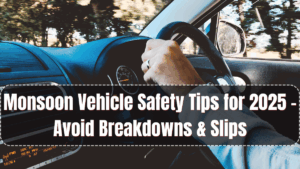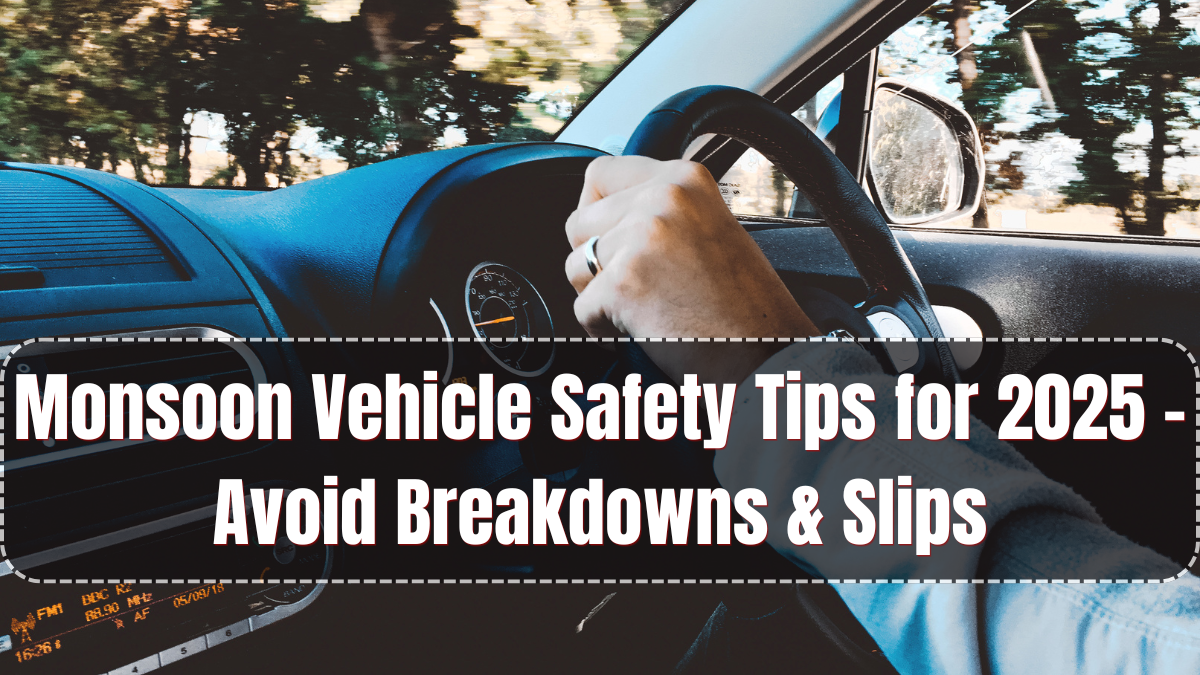The Indian monsoon season is beautiful but often brutal on roads. In 2025, with increasing rainfall intensity and unpredictable weather patterns, vehicle maintenance and road safety have become more important than ever. Whether you’re driving in a city or through rural roads, proper preparation can help you avoid breakdowns, skids, and costly repairs.
Here’s a complete checklist of the most important monsoon vehicle safety tips every driver must follow this year.

1. Check and Upgrade Your Tyres
Tyres are your vehicle’s first defense against slippery roads.
-
Ensure tread depth is above 2 mm for safe wet-surface grip
-
Replace old, worn-out tyres immediately
-
Keep tyres properly inflated—under or over-inflated tyres are dangerous in wet conditions
-
Consider installing rain grip or all-weather tyres for better control
Driving on rural or pothole-filled roads with bald tyres is a major cause of monsoon accidents.
2. Inspect Wipers and Windshield
Visibility is often the biggest challenge in the rainy season.
-
Check if your wiper blades leave streaks or make noise—if yes, replace them
-
Use anti-fog spray or gel inside the windshield to prevent misting
-
Clean wiper nozzles and top up the windshield washer fluid with rain repellent additive
-
Repair any cracks on the windshield that may worsen due to temperature changes
Good wipers and a clear windshield are non-negotiable during heavy downpours.
3. Test Headlights, Tail Lights, and Indicators
Electrical failures are common in damp weather.
-
Ensure all lights are fully functional and visible from a distance
-
Clean the light covers from dust or yellowing
-
Use hazard lights in case of reduced visibility during stormy weather
-
Switch to LED bulbs if your headlights are dim or foggy
Functional lighting is crucial not only for your vision but to ensure others see you too.
4. Seal Your Vehicle Against Water Ingress
Monsoons can lead to water entering your car’s cabin or engine.
-
Check door rubber linings and replace cracked or hardened ones
-
Inspect floor mats and keep absorbent foot mats to avoid slipping
-
Use silicone sealant in trunk and window gaps if water leaks are found
-
Avoid driving through waterlogged areas that could flood the engine or brake system
Preventive sealing can save you from expensive water damage repairs.
5. Maintain Brake Performance
Brakes often lose their sharpness during wet weather.
-
Get your brake pads and discs checked before monsoon begins
-
If you feel sponginess or delay in response, visit a mechanic immediately
-
Test brakes after driving through water to ensure they’re dry and responsive
For two-wheelers, regularly check brake cables, discs, and pedal sensitivity.
6. Battery & Wiring Protection
Rain can lead to short circuits or battery failure.
-
Clean battery terminals and apply petroleum jelly to prevent rust
-
Check all exposed wires for insulation cracks
-
Use rubber covers for fuse boxes and connectors, especially in older vehicles
-
Park under cover to avoid moisture settling on the hood and engine bay
A weak battery in monsoon can leave you stranded with no warning.
FAQs
How do I prepare my car for the monsoon in India?
Check your tyres, wipers, lights, battery, brakes, and seal any areas prone to leaks. Regular maintenance is key.
What tyre tread depth is safe for monsoon driving?
Tread depth should be at least 2 mm. Anything below that increases the risk of hydroplaning and skidding.
Are there specific car accessories for rainy season driving?
Yes, rainproof foot mats, fog lamps, rain guards, and waterproof seat covers are highly recommended.
Should I avoid waterlogged roads during monsoon?
Absolutely. Driving through deep water can damage the engine, brakes, and electrical systems. Always take alternative routes if possible.
Click here to know more.
